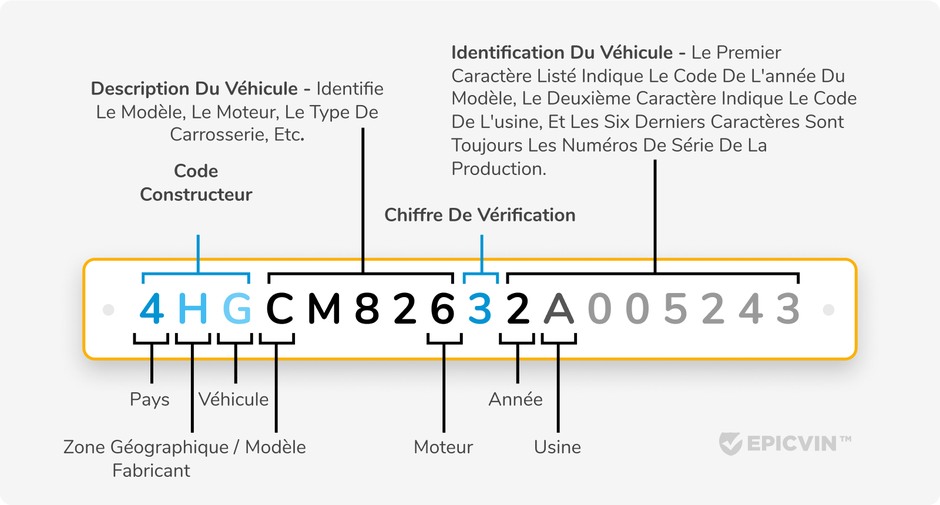
Décodage du numéro d'identification du véhicule (VIN)
Dans cet article, nous avons décrit en détail ce qu'est le code VIN.

Décodeur Lexus gratuit ! 🚗 Consultez les spécifications, la fiche technique, les rappels et l'historique de base - sans inscription. 🛡️✅ Besoin d'informations sur les accidents, le kilométrage, le titre ? Passez à la version premium en un clic.
À la recherche du VIN ?
Voici où vous le trouverez :

Le numéro d’identification du véhicule (VIN) est l’empreinte numérique de votre Lexus. Le format est standardisé depuis 1981. Cette séquence alphanumérique contient de précieuses informations. Notre décodeur VIN Lexus révèle instantanément les spécifications d’usine, les rappels et les données essentielles pour sécuriser votre achat.
Getting detailed vehicle information from your Lexus VIN takes just seconds with our decoder.

Le numéro de série (VIN) de votre Lexus est visible à plusieurs emplacements pour en faciliter l’accès et renforcer la sécurité.
| Indicateur | Signification |
|---|---|
| Historique d’accidents | ≈ 23 % des rapports EpicVIN pour Lexus présentent ≥ 1 incident (accident, carrosserie, etc.) |
| Titres salvage / reconstruits | ≈ 33 % des Lexus sur Copart ont un statut non réparable ou de récupération |
| Kilométrage moyen | ≈ 177 000 km pour une Lexus de plus de 10 ans. Moyenne annuelle : ≈ 17 600 km |
| Campagnes de rappel 2025 | 8 300 véhicules : ceinture (NX/RX) ; 65 véhicules : airbag (NX/RX) ; 10 véhicules : pompe à carburant (NX300/RX350L) |
Vérifiez le VIN avant achat : près d’une Lexus sur cinq présente des dommages. Les rapports EpicVIN — issus d’une vérification vin de Lexus — aident à éviter réparations inattendues et rappels non résolus.
| Problème | Statistiques & Détails |
|---|---|
| Panne de pompe à carburant | Toyota/Lexus a rappelé ≈ 3,34 M de véhicules : risque d’arrêt en circulation (modèles LS 460 et RX 350). Remplacement gratuit |
| Airbag rideau défectueux (TX) | Rappel 24LA05 : ≈ 33 600 Lexus TX concernées. Le rideau côté conducteur pourrait ne pas fonctionner vitre baissée. Module remplacé gratuitement |
| Ceinture 2e rangée endommagée (NX/RX) | Rappel 25LA03 : ≈ 8 400 crossovers NX/RX. Ceinture centrale endommagée en usine. Inspection et remplacement gratuits |
Remarque : Une recherche vin sur EpicVIN permet de savoir si le véhicule est concerné par ces rappels massifs ou dissimule des réparations onéreuses.

Chaque caractère du VIN véhicule une information précise :
Exemple décodé (JTJYARBZ2H2051612)
| Position | Symbole | Signification |
|---|---|---|
| 1 | J | Japon, pays d’origine |
| 2 | T | Toyota, constructeur |
| 3 | J | Véhicule particulier |
| 4-8 | YARBZ | Style SUV, type moteur, RX, niveau de finition |
| 9 | 2 | Chiffre de validation |
| 10 | H | Année modèle 2017 |
| 11 | 2 | Usine d’assemblage à Cambridge, Ontario |
| 12-17 | 051612 | Numéro de série unique |
Année 2010
Marque Lexus
Modèle LS
Type de carburant Gasoline
Moteur 4.6L V-Shaped 1UR-FSE
Fabriqué en JAPAN
Notre outil permet d’accéder à :
Citation d’expert
Avant d’envoyer un virement pour une Lexus d’occasion, entrez son VIN sur EpicVIN. En quelques secondes, vous verrez la fiche de fabrication — si elle possède le système audio Mark Levinson ou le pack F SPORT — ainsi que les rappels ouverts, les compteurs trafiqués ou les gages. Des faits qui peuvent vous éviter des dépenses énormes.— Alex Black, directeur marketing & expert auto, EpicVIN
Oui. EpicVIN permet un decode vin Lexus de base sans frais - vous verrez le modèle, le moteur, la finition, l’usine et l’année. Le rapport complet est payant.
Absolument. Saisissez le VIN sur EpicVIN et consultez la section « Rappels ». Notre base est connectée en temps réel à celle de la NHTSA.
Oui. Entrez le numero vin Lexus sur EpicVIN. Le décodeur affiche instantanément les données de base (modèle, moteur, transmission, finition, peinture, sécurité)
Entrez le VIN sur EpicVIN et ouvrez la section « Fiche de fabrication ». Nous extrayons les données des systèmes Toyota/Lexus. Pour un PDF officiel, contactez un concessionnaire.
Le vin decoder Lexus gratuit d’EpicVIN agrège des données issues de sources officielles : départements des véhicules, NMVTIS, assurances, ventes aux enchères, APIs Lexus & NHTSA pour une vérification vin de Lexus précise et fiable. Vous pouvez aussi vérifier numéro châssis gratuit pour plus de sécurité.
Découvrez des conseils d'experts, des astuces et des informations sur l'achat et l'entretien de véhicules d'occasion.

Dans cet article, nous avons décrit en détail ce qu'est le code VIN.

Notre équipe vous dira quoi faire si votre NIV est erroné.

Notre équipe vous parlera du suivi de votre plaque d'immatriculation